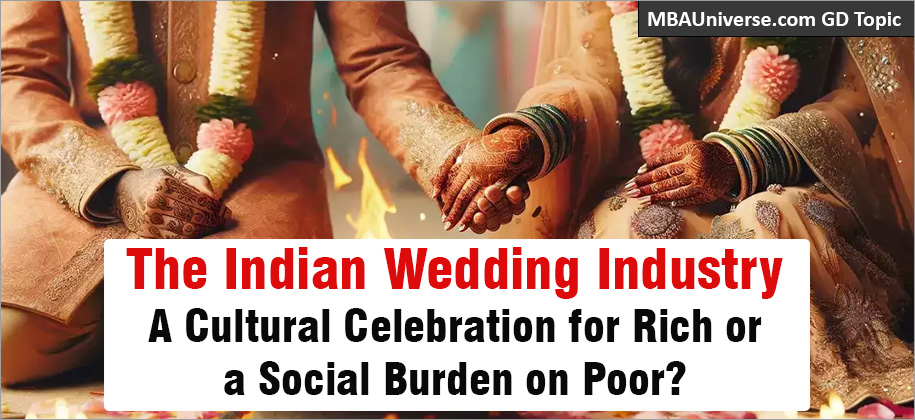Indian Wedding Industry: An Overview
The recent wedding of a son of a prominent business family in India was in news all over the world. It was attending by global business leaders, political heavyweights and Bollywood starts. Indeed, India’s wedding industry, one of the world’s most extravagant, has cultural richness with significant economic impact. The market size of Indian Wedding Industry is valued at over $50 billion, second only to the United States! It is expected to grow at 20-30% annually. Indian weddings have always been grand affairs, but recent years have seen rising debates if it is a boon for the economy or an unsustainable financial burden.
Indian wedding market thrives on diverse sectors—catering, jewellery, clothing, event management, and tourism. As families continue to spend considerable sums on weddings, often running into lakhs or crores of rupees, this industry has maintained a pivotal role in the nation’s economy. However, while these weddings boost various economic sectors, the costs have prompted discussions on whether this culture of grand weddings is financially justifiable for average families.
Arguments in Support of the Indian Wedding Industry
- Economic Contributions Across Multiple Sectors: The industry gives a boost to a wide range of sectors, from hospitality and catering to real estate. A typical large wedding might generate significant revenue across all these areas, supporting employment and entrepreneurship in both urban and rural regions.
- Preservation of Cultural Traditions: Indian weddings are deeply symbolic of cultural practices, with each region showcasing unique rituals, attire, and cuisines. These celebrations strengthen social and family ties and bond cultural values, passing them down generations.
- Tourism and International Appeal: Big Indian weddings attract not only domestic guests but also international guests and NRIs. This fuels India’s wedding tourism in cities like Jaipur. According to industry body FICCI, the wedding tourism segment is expected to grow by over 20% annually.
- Employment Creation: The wedding industry employs lakhs of people. From designers and caterers to photographers and makeup artists, they get seasonal employment. These opportunities are vital, especially those in semi urban and rural areas where wedding-related crafts like jewelry making and textile play a significant economic role.
- Boosting Local Tourism and Travel Sector: With the rise of “destination weddings,” many local economies benefit. Cities like Goa, Jaipur, Udaipur are now popular wedding destinations. This gives boost to local businesses and economy.
Arguments Against the Excessive Spending in Indian Weddings
- Financial Strain on Families: Many families spend beyond their means, taking loans and debts to meet societal expectations. A study by consulting firm KPMG found that the average cost of an Indian wedding is between ₹20 lakh and ₹1 crore. This is a high burden that can impact middle-class families for many years.
- Commercialization: The cultural essence of Indian weddings seems to be lost by commercialization. There is focus shifts to showmanship over traditions. Fashion designers, luxury venues, and salon services make weddings accessible only to the affluent. This adds pressure on the middle class to catch up.
- Environmental Impact: Weddings often consume vast amounts of resources, producing food and material waste, and contributing to air and noise pollution. Eco-conscious experts argue that weddings are becoming unsustainable, especially in tourist areas where destination welding is in vogue.
- Widening Inequality: Opulent weddings tend to promote a culture of comparison, pushing families to match or exceed societal standards. This can expand social inequality, as lower-income families struggle to meet these expectations.
- Shift Away from Minimalisms: The modern trend of “big fat Indian weddings” often goes against traditional simplicity. With minimalism becoming a main stream thought, prioritizing savings or investments over a lavish celebration would be more sustainable for middle economy like India.
Conclusion
The Indian wedding industry is a complex mixture of cultural celebration with significant financial costs. While it sustains numerous livelihoods, supports local economies, and celebrates rich traditions, it also creates financial strain on families and the environmental impact of grand celebrations. The debate continues, but with growing awareness, India’s wedding culture should shift towards upholding cultural values over crass commercialization.
Latest 2024 GD Topics
